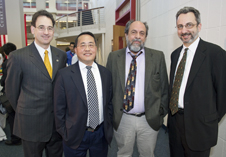University hosts national civil engineering conference

Northeastern University hosted nearly 500 engineers from across the country last week for the 2011 Engineering Mechanics Institute, which was organized by three faculty in the College of Engineering professors.
“I think it’s certainly fitting to have this conference on the campus of Northeastern University. Our university and our civil engineering program are on the move,” said Prof. Jerome F. Hajjar, one of the conference co-chairs, at the start of the event. “Our key research and education thrusts — these include environmental health, civil infrastructure security, sustainable resource engineering — all contribute to an interdisciplinary theme of urban engineering that reflects very well on many of the topics that we’re going to be having here at the conference.”
In addition to Hajjar, the conference was chaired by Prof. Ming L. Wang and co-chaired by Prof. Dionisio P. Bernal, all of whom are faculty members in Northeastern’s Department of Civil and Environmental Engineering.
The conference, which ran from Wednesday, June 1 through Saturday, June 4, focused on the intersection of academic research in engineering mechanics and the real-world applications of that scholarly work. The Engineering Mechanics Institute (EMI), part of the American Society of Civil Engineers (ASCE), works to address advanced engineering mechanics topics.
“Two of ASCE’s biggest initiatives are sustainability and infrastructure,” said Andrew Herrman, ASCE president-elect. “EMI provides the research and practical applications our country needs to achieve sustainability to improve and sustain the life of our infrastructure. This conference is a great opportunity to showcase the research that we’re doing and also the practical applications.”
Keynote speakers addressed such issues like using the use of intelligent wireless technologies to monitor the structural health of infrastructure, and lessons learned from the massive earthquake and tsunami that struck Japan in March. One of the Northeastern’s national research centers is focused on the former topic — developing sensing technology for real-time assessment of the safety and integrity of infrastructure such as roads and bridges.
In addition to portions of the conference aimed at professional engineers to the main presentations, the conference featured a workshop for graduate studies students interested in academic careers as faculty members as well as three student paper competitions.
When welcoming visiting engineers to campus, In his welcoming remarks at the start of the conference, Stephen W. Director, Northeastern’s provost and senior vice president for academic affairs, said the University was an excellent venue for the conference because both had similar goals: merging academic scholarship with real-world experience.
“Northeastern is very pleased that you chose us to be the venue for this meeting. I understand that it is this institute’s tradition to hold its meetings on university campuses and I think that’s terrific,” Director said. “We have a somewhat different approach to undergraduate education than many other universities. With cooperative education or experiential education, we believe that what students learn in the real world is just as important as what they learn in the classroom. By alternating that experience, they become better educated. Many universities do have some co-op programs, but here it’s pervasive; about 90 percent of students across the university actually go out on co-op.”




